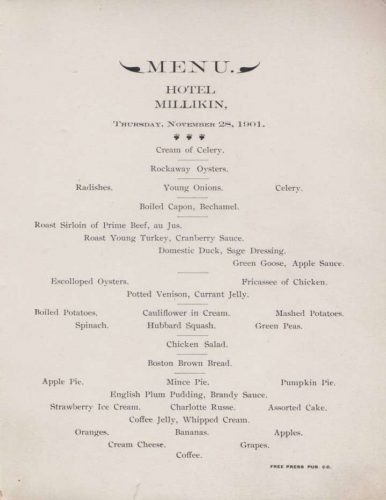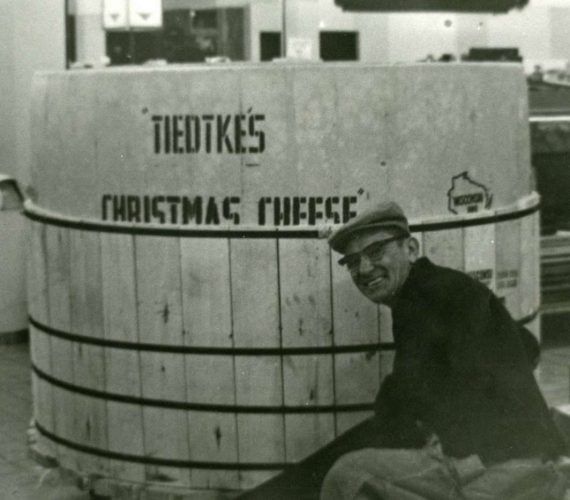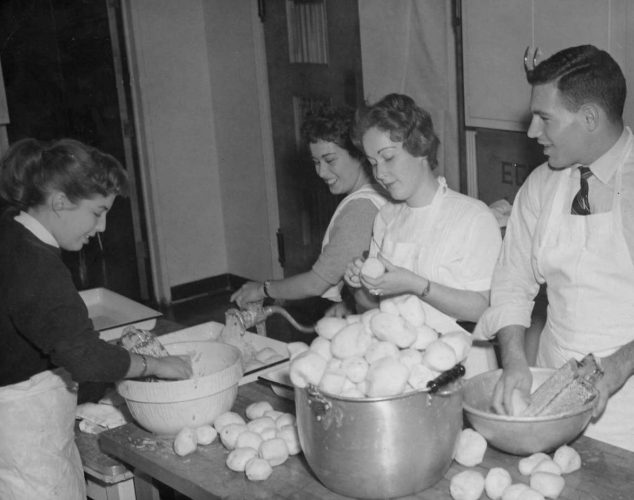Holidays Foods and Feasts


From late November through the end of the year, there seems to be no shortage of opportunities to indulge in festive foods and holiday treats, whether in our workplaces, or gathered with our friends, families and communities. This phenomenon is nothing new, though–a number of stories and images throughout Ohio Memory show how Ohioans of the past celebrated the end-of-year holidays with a variety of food traditions.
Historical menus offer us a glimpse of what it was like to experience a holiday in a specific place and time. Seen at right, the extensive spread at the Thanksgiving dinner held at the Hotel Millikin in Bowling Green, Ohio, combined seafood dishes (oysters, both Rockefeller and escalloped) with a wide variety of meats and poultry. Main dish options included capon (chicken), prime beef, venison, duck, goose, and the classic, turkey with cranberry sauce. A number of healthful veggie sides are balanced out by a delicious dessert selection–fruits, pies, ice cream, plum pudding, “coffee jelly” with whipped cream, and Charlotte Russe, a Victorian dessert similar to an icebox cake, with a custard- or cream-filled center and a crust of lady fingers. The Hotel Millikin was constructed on the corner of Wooster and Main by William Henry Millikin, a Wood County oil baron, and opened in 1897. After ceasing hotel operations in the 1950s, it was used for various businesses on its first floor, before being converted to an apartment building in the early 2000s.

Classic Christmas foods run the range from savory to sweet, including everything from fruit baskets to giant wheels of cheese. In the photograph seen at left, from the collection of the Toledo Lucas County Public Library, a man poses before the yearly Christmas cheese wheel at Tiedtke’s Department Store, ca. 1950. Tiedtke’s operated from 1894 until 1973, with multiple locations in Toledo, and a main store downtown at Summit Street and Adams. The massive cheese—a 3,200 pound Wisconsin cheddar—was a longtime and beloved annual tradition designed as a holiday promotion to draw in shoppers, who could buy it by the pound as Christmas approached. Even after the department store’s closing, other area businesses have continued the tradition.

This year, the eighth and final night of Hanukkah falls almost on the very last night of the year; the holiday runs from the evening of December 22nd through the evening of December 30th. Hanukkah is the Jewish celebration of the 2nd century BCE victory of Maccabean Jews over their Seleucid rulers in Jerusalem, who had outlawed the practice of Judaism and erected a statue of the Greek god Zeus in the Jewish temple. Following their successful revolt, the Jewish community rededicated the holy temple, but only had enough uncontaminated oil to perform the ritual for a single night. Miraculously, the oil last for eight nights—long enough to prepare a fresh supply—in what is now remembered as the “Miracle of the Oil.” Fittingly, traditional Hanukkah foods make liberal use of oil in dishes like latke (potato pancakes–seen in production in the photo to the right) and sufganiyot (doughnuts). Another element of the Hanukkah tradition is the story of Judith, a Jewish heroine who assassinated the enemy general Holofernes after plying him with cheese and wine. In her honor, dairy foods like blintzes and other cheesy goodies are traditionally shared as part of the annual celebration.
Although the food has not yet been served, you can visit Ohio Memory to see a Hanukkah celebration led by Rabbi Nathan Zelizer at Stark General Hospital in South Carolina, 1944, while Zelizer served as chaplain with the U. S. Army during World War II. Interested in trying out some Hanukkah recipes yourself? Explore the archives of the Ohio Jewish Chronicle and the Toledo Jewish News to discover options from traditional to less so.
Holiday traditions can feel especially poignant for those who are far from home—something well-documented in the materials collected in the World War I in Ohio Collection on Ohio Memory. Around late December, those serving overseas often shared details of their celebrations with friends and family at home through letters, or recorded their experiences in diaries and journals. Writing from France on December 30, 1917, Newman “Bud” Ebersole, Sergeant of the Armco Ambulance Corps, describes “a real Christmas storm” that arrived on the 25th, and a feast that consisted of “a couple of real turkeys,” government-issued, and other supplies they were able to scrounge up from the local countryside including “some fine chestnuts for dressing, eggs for poach, real salad, butter, milk for the coffee, some funny kinds of vegetables, cheese, nuts, raisins, figs, dates and some cakes.” All of this, along with a rousing party, contributed to holiday cheer, although the men all agree that “we are perfectly willing to spend the next one back with you and just “home folks.”
Whatever, wherever, and however you are celebrating this year, we hope it involves some tasty food. Happy holidays from Ohio Memory!
Thanks to Lily Birkhimer, Digital Projects Coordinator at the Ohio History Connection, for this week’s post!



Leave a Reply
You must be logged in to post a comment.